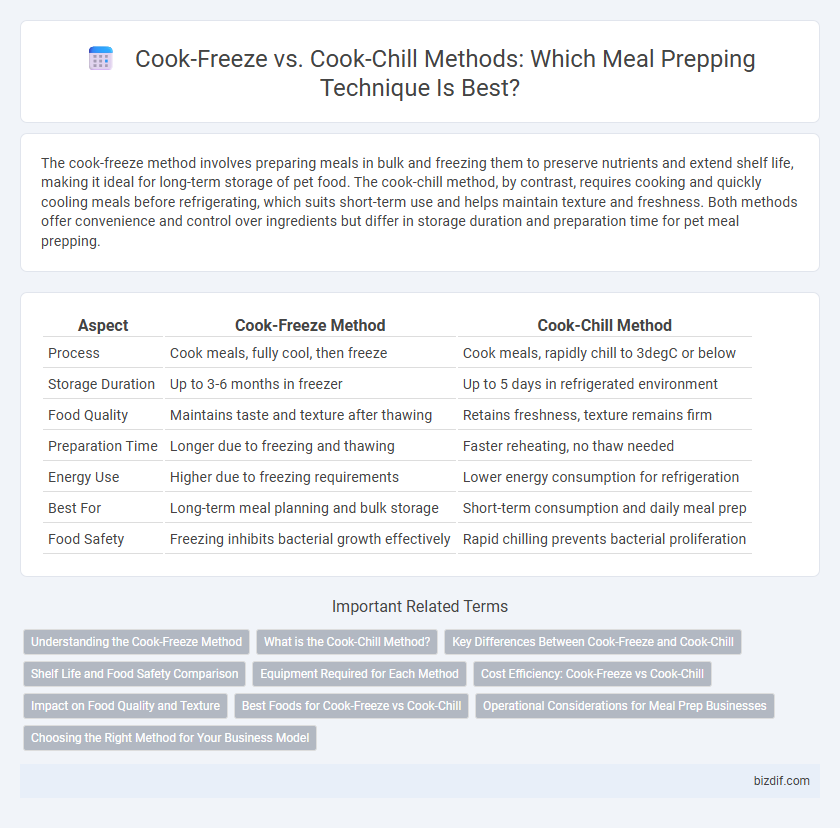The cook-freeze method involves preparing meals in bulk and freezing them to preserve nutrients and extend shelf life, making it ideal for long-term storage of pet food. The cook-chill method, by contrast, requires cooking and quickly cooling meals before refrigerating, which suits short-term use and helps maintain texture and freshness. Both methods offer convenience and control over ingredients but differ in storage duration and preparation time for pet meal prepping.
Table of Comparison
| Aspect | Cook-Freeze Method | Cook-Chill Method |
|---|---|---|
| Process | Cook meals, fully cool, then freeze | Cook meals, rapidly chill to 3degC or below |
| Storage Duration | Up to 3-6 months in freezer | Up to 5 days in refrigerated environment |
| Food Quality | Maintains taste and texture after thawing | Retains freshness, texture remains firm |
| Preparation Time | Longer due to freezing and thawing | Faster reheating, no thaw needed |
| Energy Use | Higher due to freezing requirements | Lower energy consumption for refrigeration |
| Best For | Long-term meal planning and bulk storage | Short-term consumption and daily meal prep |
| Food Safety | Freezing inhibits bacterial growth effectively | Rapid chilling prevents bacterial proliferation |
Understanding the Cook-Freeze Method
The cook-freeze method involves fully cooking meals before rapidly freezing them to preserve flavor, texture, and nutritional value for long-term storage. This process inhibits bacterial growth by quickly lowering food temperature, making it ideal for batch cooking and extended shelf life. Properly sealed and stored, cook-freeze meals maintain quality for several months, offering convenience and reducing food waste.
What is the Cook-Chill Method?
The Cook-Chill method involves cooking food thoroughly, rapidly cooling it to between 0-3degC within 90 minutes, and storing it under refrigerated conditions for up to 5 days before reheating. This process maintains food safety and quality by minimizing bacterial growth and preserving texture and flavor. Commonly used in commercial kitchens and meal prepping, the Cook-Chill method enhances convenience while ensuring nutritional retention.
Key Differences Between Cook-Freeze and Cook-Chill
The cook-freeze method involves cooking food and freezing it immediately to preserve freshness for extended periods, while the cook-chill method cools cooked food rapidly and stores it refrigerated for shorter-term use. Cook-freeze is ideal for long-term meal prepping with minimal nutritional loss, whereas cook-chill allows for quicker meal turnaround and easier portion control. Temperature control is critical in both methods to prevent bacterial growth, with cook-freeze requiring deep freezing below -18degC and cook-chill maintaining food at 0-3degC.
Shelf Life and Food Safety Comparison
The cook-freeze method extends meal shelf life up to six months by rapidly freezing cooked food, effectively halting bacterial growth and preserving nutrients. In contrast, the cook-chill method stores meals under refrigeration for up to five days, requiring strict temperature control between 0-4degC to prevent pathogen proliferation. Both methods demand proper handling and hygiene, but cook-freeze offers superior food safety with longer storage capability compared to the shorter refrigerated shelf life of cook-chill.
Equipment Required for Each Method
The cook-freeze method requires heavy-duty freezing equipment such as blast freezers or commercial-grade freezers capable of rapidly reducing food temperature to preserve texture and flavor. Cook-chill method demands specialized chilling units or ice-water baths to quickly cool cooked meals to safe temperatures before storage in refrigerated units. Both methods benefit from vacuum sealers or airtight containers to extend shelf life and prevent freezer burn or spoilage.
Cost Efficiency: Cook-Freeze vs Cook-Chill
Cook-freeze method offers greater cost efficiency by extending shelf life up to several months, reducing food waste and allowing bulk purchasing at lower prices. Cook-chill requires refrigerated storage with shorter shelf life of 3-5 days, leading to more frequent inventory turnover and potential spoilage. Energy costs are generally lower for freezing compared to continuous refrigeration needed in cook-chill systems.
Impact on Food Quality and Texture
The cook-freeze method preserves food quality by slowing enzymatic activity and microbial growth, maintaining texture through rapid freezing that prevents ice crystal formation. In contrast, the cook-chill method retains moisture and freshness by cooling food quickly to refrigerated temperatures, which helps preserve a firmer texture but may cause slight degradation over time. Both methods impact food texture differently, with cook-freeze offering longer storage and cook-chill providing quicker consumption with fresher mouthfeel.
Best Foods for Cook-Freeze vs Cook-Chill
Cook-freeze method is ideal for ingredients like cooked meats, soups, and casseroles that retain texture and flavor when frozen and reheated. Cook-chill suits fresh vegetables, pasta, and dairy-based dishes that benefit from quick cooling and refrigeration to preserve freshness without freezing damage. Understanding food composition helps optimize meal prepping by matching the method to the best food types for taste and safety.
Operational Considerations for Meal Prep Businesses
The cook-freeze method requires blast chilling meals to -18degC for long-term storage, optimizing inventory management and extending shelf life up to several months, which benefits high-volume meal prep businesses with diverse menus. The cook-chill method involves rapidly cooling meals to 0-3degC, enabling same-week consumption while maintaining nutritional quality, making it ideal for businesses prioritizing quick turnover and minimal freezer space. Operational considerations include the necessary equipment investment, workflow adaptation, and compliance with food safety regulations specific to temperature control and storage duration.
Choosing the Right Method for Your Business Model
The cook-freeze method extends shelf life by freezing meals after cooking, ideal for businesses prioritizing long-term storage and distribution flexibility. Cook-chill involves rapidly cooling meals for refrigeration, supporting quick turnaround times and immediate consumption demands in local markets. Selecting between these methods depends on factors such as delivery range, storage capacity, and customer consumption patterns to optimize freshness and operational efficiency.
Cook-freeze method vs Cook-chill method Infographic

 bizdif.com
bizdif.com